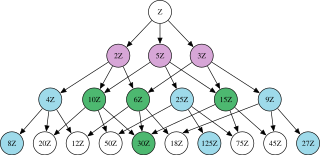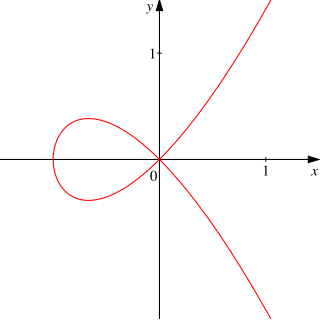
Algebraic geometry is a branch of mathematics which uses abstract algebraic techniques, mainly from commutative algebra, to solve geometrical problems. Classically, it studies zeros of multivariate polynomials; the modern approach generalizes this in a few different aspects.
In mathematics Hilbert's basis theorem asserts that every ideal of a polynomial ring over a field has a finite generating set.

In algebra, a prime ideal is a subset of a ring that shares many important properties of a prime number in the ring of integers. The prime ideals for the integers are the sets that contain all the multiples of a given prime number, together with the zero ideal.
In commutative algebra, the Krull dimension of a commutative ring R, named after Wolfgang Krull, is the supremum of the lengths of all chains of prime ideals. The Krull dimension need not be finite even for a Noetherian ring. More generally the Krull dimension can be defined for modules over possibly non-commutative rings as the deviation of the poset of submodules.
In mathematics, Hilbert's Nullstellensatz is a theorem that establishes a fundamental relationship between geometry and algebra. This relationship is the basis of algebraic geometry. It relates algebraic sets to ideals in polynomial rings over algebraically closed fields. This relationship was discovered by David Hilbert, who proved the Nullstellensatz in his second major paper on invariant theory in 1893.

In algebraic geometry and commutative algebra, the Zariski topology is a topology defined on geometric objects called varieties. It is very different from topologies that are commonly used in real or complex analysis; in particular, it is not Hausdorff. This topology was introduced primarily by Oscar Zariski and later generalized for making the set of prime ideals of a commutative ring a topological space.

Commutative algebra, first known as ideal theory, is the branch of algebra that studies commutative rings, their ideals, and modules over such rings. Both algebraic geometry and algebraic number theory build on commutative algebra. Prominent examples of commutative rings include polynomial rings; rings of algebraic integers, including the ordinary integers ; and p-adic integers.

Algebraic varieties are the central objects of study in algebraic geometry, a sub-field of mathematics. Classically, an algebraic variety is defined as the set of solutions of a system of polynomial equations over the real or complex numbers. Modern definitions generalize this concept in several different ways, while attempting to preserve the geometric intuition behind the original definition.
In algebra, ring theory is the study of rings, algebraic structures in which addition and multiplication are defined and have similar properties to those operations defined for the integers. Ring theory studies the structure of rings; their representations, or, in different language, modules; special classes of rings ; related structures like rngs; as well as an array of properties that prove to be of interest both within the theory itself and for its applications, such as homological properties and polynomial identities.

In algebraic geometry, an affine algebraic set is the set of the common zeros over an algebraically closed field k of some family of polynomials in the polynomial ring An affine variety or affine algebraic variety, is an affine algebraic set such that the ideal generated by the defining polynomials is prime.
In mathematics, and more specifically in computer algebra, computational algebraic geometry, and computational commutative algebra, a Gröbner basis is a particular kind of generating set of an ideal in a polynomial ring K[x1, ..., xn] over a field K. A Gröbner basis allows many important properties of the ideal and the associated algebraic variety to be deduced easily, such as the dimension and the number of zeros when it is finite. Gröbner basis computation is one of the main practical tools for solving systems of polynomial equations and computing the images of algebraic varieties under projections or rational maps.
In mathematics, especially in the field of algebra, a polynomial ring or polynomial algebra is a ring formed from the set of polynomials in one or more indeterminates with coefficients in another ring, often a field.
In commutative algebra, a regular local ring is a Noetherian local ring having the property that the minimal number of generators of its maximal ideal is equal to its Krull dimension. In symbols, let A be any Noetherian local ring with unique maximal ideal m, and suppose a1, ..., an is a minimal set of generators of m. Then Krull's principal ideal theorem implies that n ≥ dim A, and A is regular whenever n = dim A.
In the theory of multivariate polynomials, Buchberger's algorithm is a method for transforming a given set of polynomials into a Gröbner basis, which is another set of polynomials that have the same common zeros and are more convenient for extracting information on these common zeros. It was introduced by Bruno Buchberger simultaneously with the definition of Gröbner bases.
In mathematics, Hilbert's syzygy theorem is one of the three fundamental theorems about polynomial rings over fields, first proved by David Hilbert in 1890, that were introduced for solving important open questions in invariant theory, and are at the basis of modern algebraic geometry. The two other theorems are Hilbert's basis theorem, which asserts that all ideals of polynomial rings over a field are finitely generated, and Hilbert's Nullstellensatz, which establishes a bijective correspondence between affine algebraic varieties and prime ideals of polynomial rings.
In mathematics, the Noether normalization lemma is a result of commutative algebra, introduced by Emmy Noether in 1926. It states that for any field k, and any finitely generated commutative k-algebraA, there exist elements y1, y2, ..., yd in A that are algebraically independent over k and such that A is a finitely generated module over the polynomial ring S = k [y1, y2, ..., yd]. The integer d is equal to the Krull dimension of the ring A; and if A is an integral domain, d is also the transcendence degree of the field of fractions of A over k.
In commutative algebra, the Hilbert function, the Hilbert polynomial, and the Hilbert series of a graded commutative algebra finitely generated over a field are three strongly related notions which measure the growth of the dimension of the homogeneous components of the algebra.
This is a glossary of commutative algebra.
In algebraic geometry, the main theorem of elimination theory states that every projective scheme is proper. A version of this theorem predates the existence of scheme theory. It can be stated, proved, and applied in the following more classical setting. Let k be a field, denote by the n-dimensional projective space over k. The main theorem of elimination theory is the statement that for any n and any algebraic variety V defined over k, the projection map sends Zariski-closed subsets to Zariski-closed subsets.
In abstract algebra, a monomial ideal is an ideal generated by monomials in a multivariate polynomial ring over a field.



























